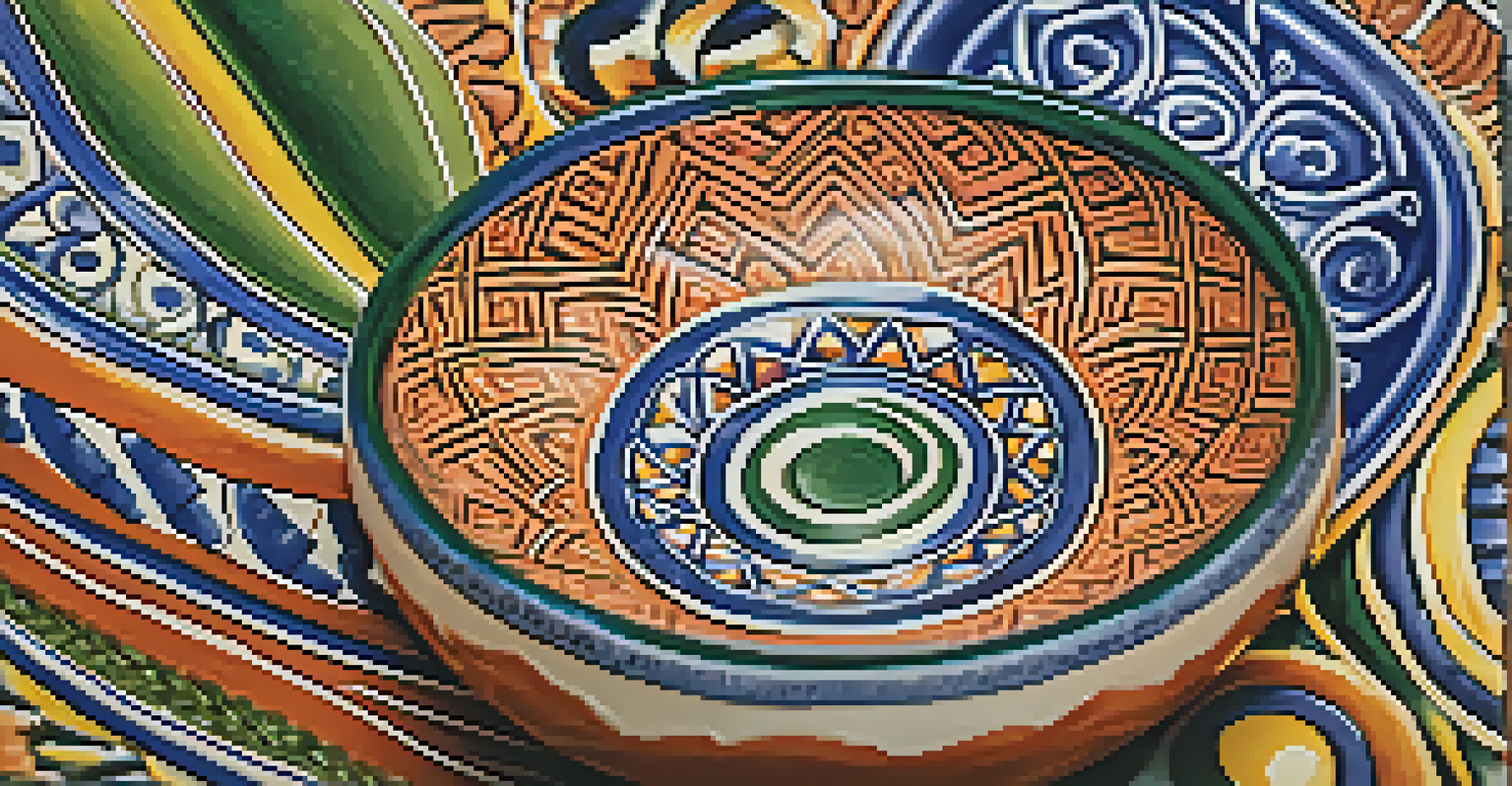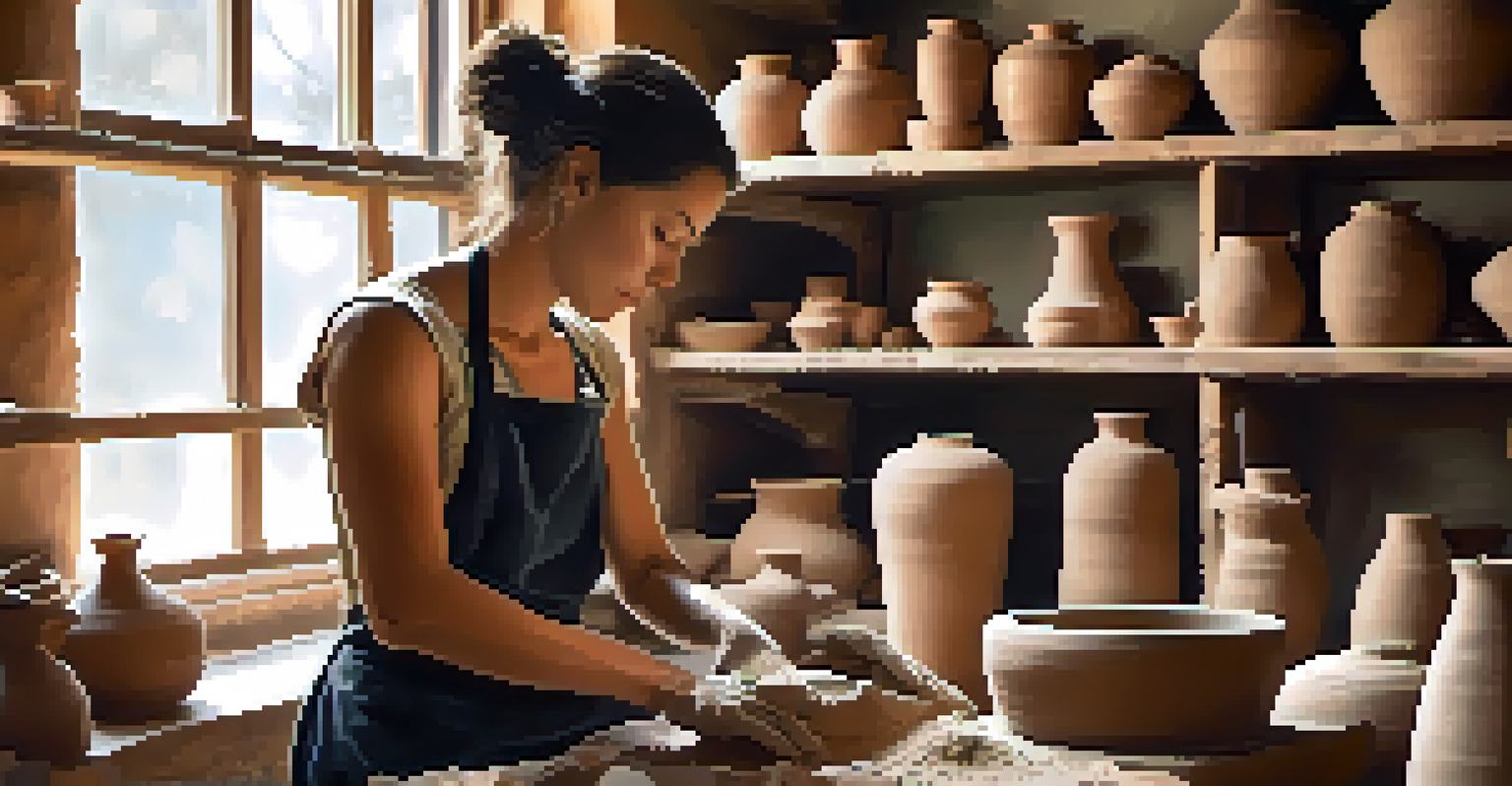Handmade Pottery: The Artistry of Brazilian Ceramics

The Rich History of Brazilian Ceramics
Brazilian ceramics have a vibrant history that dates back centuries, intertwining with the cultures of indigenous peoples and colonizers. Each piece tells a story, reflecting the traditions and techniques passed down through generations. This history is not just about pottery; it encompasses the evolution of art and utility in Brazilian society.
Art is the most beautiful of all lies.
The influence of indigenous techniques is particularly notable, with many artisans still using methods that have been practiced for millennia. These traditional approaches often incorporate natural materials sourced locally, which adds to the authenticity and connection to the land. As a result, each piece is unique, embodying the spirit of its origin.
Today, this rich heritage continues to inspire contemporary artists who blend traditional techniques with modern aesthetics. This fusion creates a diverse range of pottery that appeals to both local and international markets, showcasing the enduring legacy of Brazilian craftsmanship.
Materials and Techniques Used in Pottery
One of the hallmarks of Brazilian pottery is the use of natural materials, such as clay sourced from the earth, which varies in color and texture by region. Artisans meticulously select their materials to ensure each piece resonates with its intended aesthetic and purpose. This attention to detail is what sets handmade pottery apart from mass-produced items.

Traditional techniques often include hand-building methods like coiling or pinching, where artisans shape the clay with their hands rather than using a potter's wheel. This approach not only emphasizes the artisan's touch but also allows for greater creativity, resulting in organic and often asymmetrical forms. Each technique carries its own charm and story, making every item a work of art.
Rich Heritage of Brazilian Ceramics
Brazilian ceramics reflect a vibrant history influenced by indigenous cultures and modern artistry, showcasing unique stories through each piece.
In addition to shaping, glazing is another critical step in the pottery-making process. Brazilian artisans often use natural pigments derived from local plants and minerals for their glazes, resulting in vivid colors that reflect the country's rich biodiversity. This sustainable practice enhances the beauty of the pottery while staying true to the environment.
Cultural Significance of Handmade Pottery
Handmade pottery in Brazil is more than just functional art; it plays a significant role in cultural rituals and community gatherings. Many pieces are crafted with specific purposes in mind, such as serving traditional dishes during festive occasions. This connection to food and celebration highlights the importance of pottery in social and cultural contexts.
The craftsman is not a mere laborer; he is the artist of his work.
Moreover, pottery-making is often a communal activity that brings families and neighborhoods together. Workshops and studios become places of learning and sharing, where skills are passed down and new ideas are sparked. This collaborative spirit fosters a sense of belonging and pride within communities, making pottery a vital part of cultural identity.
The stories behind each piece often reflect the local traditions, folklore, and values of the region. As artisans create pottery, they imbue it with meaning, allowing future generations to connect with their heritage. In this way, handmade pottery serves as a vessel of culture, preserving history for years to come.
The Role of Technology in Modern Pottery
While traditional methods remain at the heart of Brazilian pottery, modern technology has started to play a role in the crafting process. Tools such as electric wheels and kilns can enhance efficiency and precision, allowing artisans to experiment with new forms and designs. This blend of old and new can result in exciting innovations in the pottery world.
Social media and online platforms have also revolutionized how artisans market their work. By showcasing their creations online, Brazilian potters can reach a global audience, sharing their artistry and culture beyond local markets. This exposure not only boosts sales but also fosters a greater appreciation for handmade pottery.
Sustainable Practices in Pottery
Many Brazilian artisans prioritize eco-friendly methods, sourcing local materials and using natural glazes to honor the environment.
However, many artisans are careful to maintain the traditional aspects of their craft, ensuring that technology complements rather than replaces their artistry. The challenge lies in finding the right balance between preserving heritage and embracing innovation, a journey that continues to evolve in the pottery community.
Exploring Different Styles of Brazilian Pottery
Brazilian pottery is incredibly diverse, with various regions boasting distinct styles and techniques. For instance, the ceramics from the Northeast are often characterized by bright colors and intricate patterns, reflecting the vibrant culture of the area. Each style tells a different story, showcasing the rich tapestry of influences that shape Brazilian art.
In contrast, the pottery from Minas Gerais tends to emphasize earthy tones and rustic finishes, often featuring more subtle designs that echo the natural landscape. This regional variation highlights the adaptability of artisans to their surroundings, as they draw inspiration from local materials and cultural expressions.
Additionally, contemporary artists are experimenting with these traditional styles, incorporating modern design elements and concepts. This fusion creates a dynamic and evolving pottery scene that honors the past while looking towards the future, inviting everyone to appreciate the artistry of Brazilian ceramics.
Sustainable Practices in Pottery Production
Sustainability is becoming an increasingly important aspect of pottery production in Brazil. Many artisans prioritize eco-friendly practices, from sourcing clay locally to utilizing natural glazes, ensuring their craft honors the environment. This conscious approach resonates with consumers who are becoming more aware of the impact of their purchases.
Additionally, some potters engage in community initiatives that promote environmental stewardship. By teaching sustainable techniques and supporting local ecosystems, these artists are not only preserving their craft but also contributing to the health of their communities. This commitment to sustainability enhances the value of handmade pottery, making it a thoughtful choice for buyers.
Diverse Regional Styles
Brazilian pottery features distinct regional styles, from the bright colors of the Northeast to the earthy tones of Minas Gerais, each telling its own story.
As the global market shifts towards sustainability, Brazilian ceramic artisans are well-positioned to attract eco-conscious consumers. Their dedication to responsible practices not only elevates their artistry but also aligns with a growing movement that values craftsmanship and environmental care.
Where to Find Authentic Brazilian Pottery
If you're eager to explore the world of Brazilian ceramics, there are several avenues to discover authentic pieces. Local artisan markets and craft fairs are excellent places to meet potters, learn about their techniques, and purchase unique items directly from the creators. This personal connection adds an extra layer of appreciation to your pottery.
Online platforms also offer a plethora of options for finding handmade Brazilian pottery. Many artisans have established their own e-commerce sites or sell through platforms dedicated to handmade goods. This accessibility allows you to browse a diverse selection of styles and prices, making it easier to find the perfect piece for your collection.

Lastly, consider visiting pottery studios and workshops during a trip to Brazil. Many artisans welcome visitors and offer classes or demonstrations, providing an immersive experience into the world of pottery-making. Whether you're a collector or simply curious, engaging with the art form firsthand enriches your understanding of its beauty and significance.